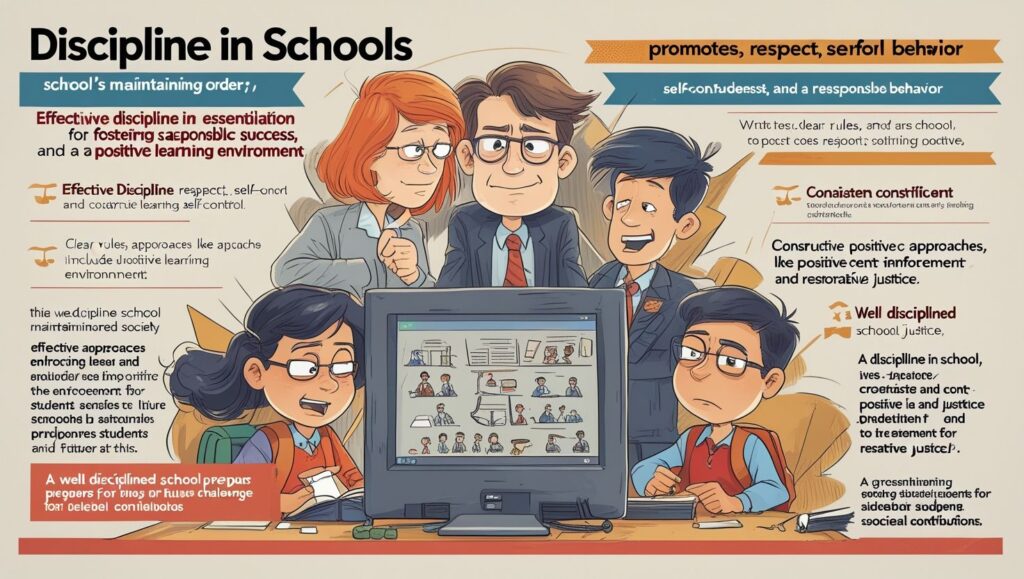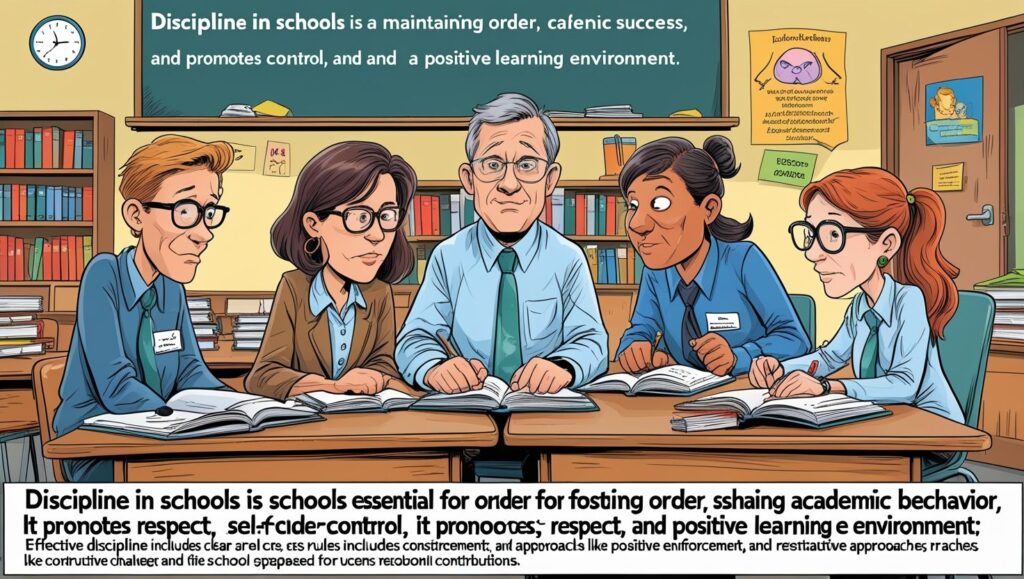Introduction
The Role of Discipline in a School,Discipline is one of the most crucial aspects of a well-functioning school environment. It serves as the foundation for academic success, personal development, and social harmony. In schools, discipline is not merely about enforcing rules and punishing misconduct; it is about cultivating self-control, responsibility, and respect among students. A disciplined environment fosters learning, enhances student behavior, and prepares young individuals for future challenges in both personal and professional life.
This article explores the role of discipline in schools, its importance, different disciplinary approaches, the impact of discipline on academic performance, and strategies for maintaining an effective disciplinary system.
The Importance of Discipline in Schools
Discipline in schools plays a vital role in shaping students’ character and behavior. Below are some key reasons why discipline is essential:
1. Promotes a Positive Learning Environment
A disciplined classroom ensures that students remain focused, attentive, and engaged in their studies. Without discipline, classrooms can become chaotic, making it difficult for teachers to teach and students to learn effectively.
2. Encourages Responsibility and Self-Control
Discipline helps students develop self-regulation and accountability. When students understand the consequences of their actions, they learn to make better choices and take responsibility for their behavior.
3. Enhances Academic Performance
Research has shown that disciplined students perform better academically. A structured environment minimizes distractions, allowing students to concentrate on their studies and achieve higher grades.
4. Prepares Students for the Future
Schools are not just centers for academic learning but also places where students develop life skills. Discipline teaches time management, perseverance, and respect for authority—qualities that are essential for success in higher education and the workplace.
5. Reduces Behavioral Issues
A well-disciplined school has fewer instances of bullying, violence, and misconduct. Clear rules and consistent enforcement help maintain order and ensure student safety.

Different Approaches to Discipline in Schools
Different schools adopt various disciplinary methods based on their educational philosophy, cultural context, and student needs. Some common approaches include:
1. Traditional Discipline (Authoritarian Approach)
This method relies on strict rules and punitive measures for misconduct. Detentions, suspensions, and expulsions are common consequences. While this approach can maintain order, critics argue that it may suppress creativity and create fear rather than understanding.
2. Positive Discipline (Democratic Approach)
Positive discipline focuses on guiding students rather than punishing them. It involves setting clear expectations, reinforcing good behavior, and using constructive consequences (e.g., reflection sheets, counseling). This approach encourages mutual respect and helps students understand the impact of their actions.
3. Restorative Justice Approach
Restorative justice emphasizes repairing harm rather than punishing offenders. Students involved in conflicts participate in mediation sessions to resolve issues amicably. This method fosters empathy, accountability, and conflict-resolution skills.
4. Behavior Modification Techniques
This approach uses rewards and reinforcements to encourage positive behavior. Teachers may implement token systems, praise, or privileges to motivate students to follow rules.
5. Self-Discipline and Moral Education
Some schools focus on teaching self-discipline through moral education, character-building programs, and mindfulness practices. Students learn to regulate their behavior internally rather than relying solely on external enforcement.
The Impact of Discipline on Academic Performance
Discipline has a direct correlation with academic success. Studies indicate that schools with strong disciplinary policies experience:
- Higher Attendance Rates: Students are more likely to attend school regularly in a structured environment.
- Improved Classroom Engagement: Fewer disruptions mean more time for meaningful learning.
- Better Teacher-Student Relationships: Clear expectations reduce conflicts and foster mutual respect.
- Higher Test Scores: Disciplined students are more focused and perform better in exams.
Conversely, a lack of discipline can lead to:
- Increased dropout rates
- Poor academic performance
- Higher incidents of violence and bullying
- Low teacher morale

Strategies for Maintaining Effective Discipline in Schools
To create a disciplined yet nurturing school environment, educators and administrators should implement the following strategies:
1. Clear and Consistent Rules
Schools must establish well-defined rules and ensure that all students understand them. Consistency in enforcement prevents confusion and reinforces accountability.
2. Positive Reinforcement
Recognizing and rewarding good behavior encourages students to follow rules willingly. Praise, certificates, and incentives can motivate students to maintain discipline.
3. Effective Classroom Management
Teachers should use engaging teaching methods, maintain eye contact, and address disruptions calmly. Proactive strategies like seating arrangements and interactive lessons can minimize misbehavior.
4. Parental Involvement
Parents play a crucial role in reinforcing discipline. Schools should communicate regularly with parents and involve them in disciplinary decisions when necessary.
5. Counseling and Mentorship
Some students misbehave due to underlying emotional or social issues. Counseling services and mentorship programs can help address these problems constructively.
6. Student Participation in Rule-Making
Involving students in creating classroom rules increases their sense of ownership and responsibility. They are more likely to follow guidelines they helped establish.
7. Professional Development for Teachers
Teachers should receive training on modern disciplinary techniques, conflict resolution, and classroom management to handle behavioral issues effectively.
Challenges in Maintaining Discipline
Despite its importance, maintaining discipline in schools comes with challenges, including:
- Cultural Differences: What is considered disciplined behavior in one culture may differ in another.
- Overemphasis on Punishment: Excessive punishment can lead to resentment and rebellion.
- Lack of Resources: Schools with limited staff and funding may struggle to implement effective disciplinary measures.
- Behavioral Disorders: Some students may have ADHD, oppositional defiant disorder (ODD), or other conditions that affect behavior.
Conclusion
Discipline is the backbone of a successful educational system. It ensures a safe, structured, and conducive learning environment where students can thrive academically and personally. While traditional punitive methods have their place, modern approaches like positive discipline and restorative justice offer more sustainable solutions by fostering mutual respect and self-regulation.
Schools must strike a balance between maintaining order and nurturing students’ emotional and social growth. By implementing clear rules, positive reinforcement, and supportive interventions, educators can cultivate a disciplined yet compassionate school culture that prepares students for lifelong success.
Ultimately, discipline in schools is not about control but about guidance—helping young individuals develop into responsible, respectful, and resilient adults.

I am regular visitor, how are you everybody? This post posted at this web page is actually nice.
https://digi332sa.netlify.app/research/digi332sa-(165)
The whole look was the perfect match for the couple’s tradition-filled day.